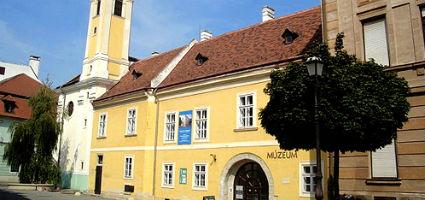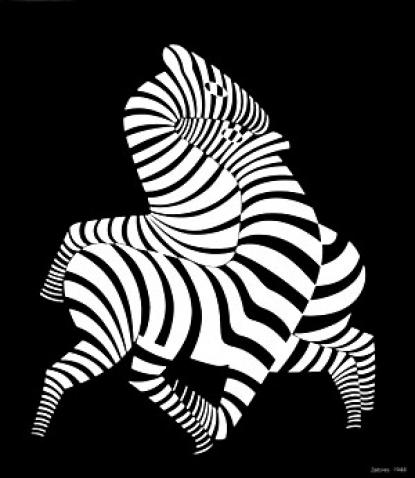2025. August 2. Saturday
Municipal Museum of Art - Péter Váczy Collection - Győr
 |
Address: 9022, Győr Nefelejcs köz 3.
Phone number: (96) 318-141
E-mail: kozmuzeum@t-online.hu
Opening hours: Tue-Sun 10-18
05.07-31.08.2011.: Tue-Sun 14-20 |
The exhibition has closed for visitors.
2008.10.24. - 2008.12.14.
Museum tickets, service costs:
|
Individual ticket for adults
|
700 HUF
|
|
|
Individual ticket for students
|
350 HUF
|
|
|
Individual ticket for pensioners
|
350 HUF
|
|
|
Individual combined ticket
|
2500 HUF
|
/ 3 days
|
|
Guide
|
3000 HUF
|
|
|
Guide
|
6000 HUF
|
The material of the showing was selected by the Municipal Museum of Arts from the Vasarely Museum of Pécs trying to provide a concise picture of Vasarely's motifs, solutions and concerns. 42 sieve prints from the most exciting artistic era of Vasarely, from the 1950-60 to be seen at the museum in Győr.

The showing was organized on the 30th birthday of the National Theatre of Győr honouring the master Vasarely whose large mosaic has ornamented the theatre building for three years now.
Victor Vasarely offered 42 sieve prints to the museum of the town of his birth in 1969. In 1976 the Vasarely Museum opened in Pécs hosting 2 million visitors a year from around the world ever since its opening.
Vasarely first met Bauhaus, its concerns and intentions as an applied graphic artist in Budapest at the studio led by Bortnyik Sándor. In 1930 he travailed to France where he was concerned with illusion-like spaces and kinetic perspective during his work as graphic designer.
His main works during his first stage in Paris were "The Zebra" (1938/60) "The Zebres" (1939/60) carpets, his steps towards op art. His main topics became abstract weaving spirals, squares looking with plastic effect and the possibility of building sorgani forms of static elements. With chiselling his compositional principles, he produced significant op art.
He began painting at the turn of the 1930/40. His early pictures were permeated by graphic approach but he worked with a rich scale of colours that resulted in colourful lyrical abstract art. His approach then still very much in favour of spectacle changed entirely soon. In 1947 he clearly realized what pure form meant for him, the essence of abstraction of pure colour. From then on, he worked with geometric structures and homogenous colours. He was in search of elementary simplicity and ancient forms. He studied the forms of nature. He made a new order of them.
His Crystal Era began in 1948 when he studied the formal elements of the buildings and Middle Ages structures of the southern French small town Gordes. The windows turned into cut squared, rhombus shaped forms and the shadows positive/negative spaces that he continued to abstract and set up in orderly geometric structures to create crystal-like spaces Illusionary effects became his most important concerns, he created he oeuvre with solving them.
This artistic period was ruled by bright colours. Later on his paintings turned to black-and-white and monochrome. he made more intricate and complex compositions that often had arched forms and saw teeth as basic motifs. Spaces often divided or finely shadowed each other.
His kinetic era began in 1950. The essence of this period was the reviving the sensation of motion by moving the contrasting elements. These were the times when architecture caught his eye. Vasarely believed in the integration of art, large, monumental artworks that are able to form the appearance of a town, to be able to express the relationship of artists living in town and the town itself.
In 1954 he was commissioned to do three large artworks by the Town designer of the University of Caracas that led to his artistic period "colourful town". His art was fulfilled these days. He did synthesising artworks where the results of former concerns summarized on a higher level.
The main issue of his kinetic era was the optical regularity of time and motion and the spatial representation of perspective imaging that resulted in the illusion of space by the viewer without motion. Connecting half sphere and three rhombuses was one of his favourite topics. His compositions and spatial figures were pure, his colour tones grew richer.
Victor Vasarely distributed his paintings as sieve prints so that people could purchase them. He believed in the democracy of artwork and art.

The showing was organized on the 30th birthday of the National Theatre of Győr honouring the master Vasarely whose large mosaic has ornamented the theatre building for three years now.
Victor Vasarely offered 42 sieve prints to the museum of the town of his birth in 1969. In 1976 the Vasarely Museum opened in Pécs hosting 2 million visitors a year from around the world ever since its opening.
Vasarely first met Bauhaus, its concerns and intentions as an applied graphic artist in Budapest at the studio led by Bortnyik Sándor. In 1930 he travailed to France where he was concerned with illusion-like spaces and kinetic perspective during his work as graphic designer.
His main works during his first stage in Paris were "The Zebra" (1938/60) "The Zebres" (1939/60) carpets, his steps towards op art. His main topics became abstract weaving spirals, squares looking with plastic effect and the possibility of building sorgani forms of static elements. With chiselling his compositional principles, he produced significant op art.
He began painting at the turn of the 1930/40. His early pictures were permeated by graphic approach but he worked with a rich scale of colours that resulted in colourful lyrical abstract art. His approach then still very much in favour of spectacle changed entirely soon. In 1947 he clearly realized what pure form meant for him, the essence of abstraction of pure colour. From then on, he worked with geometric structures and homogenous colours. He was in search of elementary simplicity and ancient forms. He studied the forms of nature. He made a new order of them.
His Crystal Era began in 1948 when he studied the formal elements of the buildings and Middle Ages structures of the southern French small town Gordes. The windows turned into cut squared, rhombus shaped forms and the shadows positive/negative spaces that he continued to abstract and set up in orderly geometric structures to create crystal-like spaces Illusionary effects became his most important concerns, he created he oeuvre with solving them.
This artistic period was ruled by bright colours. Later on his paintings turned to black-and-white and monochrome. he made more intricate and complex compositions that often had arched forms and saw teeth as basic motifs. Spaces often divided or finely shadowed each other.
His kinetic era began in 1950. The essence of this period was the reviving the sensation of motion by moving the contrasting elements. These were the times when architecture caught his eye. Vasarely believed in the integration of art, large, monumental artworks that are able to form the appearance of a town, to be able to express the relationship of artists living in town and the town itself.
In 1954 he was commissioned to do three large artworks by the Town designer of the University of Caracas that led to his artistic period "colourful town". His art was fulfilled these days. He did synthesising artworks where the results of former concerns summarized on a higher level.
The main issue of his kinetic era was the optical regularity of time and motion and the spatial representation of perspective imaging that resulted in the illusion of space by the viewer without motion. Connecting half sphere and three rhombuses was one of his favourite topics. His compositions and spatial figures were pure, his colour tones grew richer.
Victor Vasarely distributed his paintings as sieve prints so that people could purchase them. He believed in the democracy of artwork and art.
